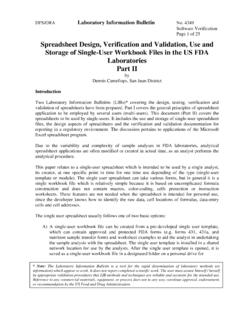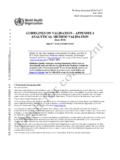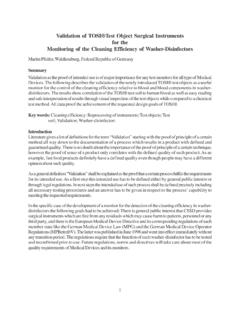Transcription of 3D Verification Problems - RISA
1 RISA 3D Rapid Interactive Structural Analysis 3 Dimensional Verification Problems 26632 Towne Centre Drive, Suite 210 Foothill Ranch, California 92610 (949) 951 5815 (949) 951 5848 (FAX) Copyright 2012 by RISA Technologies, LLC. All rights reserved. No portion of the contents of this publication may be reproduced or transmitted in any means without the express written permission of RISA Technologies, LLC. We have done our best to insure that the material found in this publication is both useful and accurate. However, please be aware that errors may exist in this publication, and that RISA Technologies, LLC makes no guarantees concerning accuracy of the information found here or in the use to which it may be put.
2 I Table of Contents Verification Overview .. 1 Verification problem 1: Truss Model Axial Loads .. 2 Verification problem 2: Cantilever Model Deflections .. 4 Verification problem 3: Member Force Comparison .. 6 Verification problem 4: Thermal Loads .. 8 Verification problem 5: Hot Rolled Steel Frame Design .. 10 Verification problem 6: Spiral Staircase Force Comparison .. 40 Verification problem 7: Beam Frequency Model .. 42 Verification problem 8: Plate Element Bending .. 44 Verification problem 9: Dynamic and Response Spectra Analysis .. 47 Verification problem 10: Wood Frame Design .. 50 Verification problem 11: Tapered Hot Rolled WF Comparison.
3 62 Verification problem 12: P Delta Displacements .. 66 Verification problem 13: Projected Loads Comparison .. 72 Verification problem 14: Solid Element Deflection .. 74 1 Verification Overview Verification Methods We at RISA Technologies maintain a library of dozens of test Problems used to validate the computational aspects of RISA programs. In this Verification package we present a representative sample of these test Problems for your review. These test Problems should not necessarily be used as design examples; in some cases the input and assumptions we use in the test Problems may not match what a design engineer would do in a real world application.
4 The input for these test Problems was formulated to test RISA 3D s performance, not necessarily to show how certain structures should be modeled. The RISA 3D solutions for each of these Problems are compared to either hand calculations or solutions from other well established programs. By well established we mean programs that have been in general use for many years, such as the Berkeley SAPIV program. The original SAPIV program is still the basis for several commercial programs currently on the market (but not RISA 3D). The reasoning is if two or more independently developed programs that use theoretically sound solution methods arrive at the same results for the same problem , those results are correct.
5 The likelihood that both programs will give the same wrong answers is considered extremely remote. If discrepancies occur between the RISA 3D and the SAPIV results during testing, we don t automatically assume SAPIV is correct. Additional testing and hand calculations are used to verify which solution (if either) is correct. There are instances where SAPIV results have been proven to be incorrect. The data for each of these Verification Problems is provided. The files are Verification problem for problem 1, Verification problem for problem 2, etc. When you install RISA 3D these data files are copied into the C:\RISA\Examples directory. If you want to run any of these Problems yourself, just read in the appropriate data file and have at it.
6 Verification Version This document contains Problems that have been verified in RISA 3D version 2 Verification problem 1 problem Statement This problem is a typical truss model (please see Figure below). The members are pinned at both ends, thus they behave as truss elements. This particular problem is presented as example on page 171 of Structural Analysis and Design by Ketter, Lee, and Prawel. The text lists Q as the load magnitude and a as the panel width. For this solution Q is taken as 10 kN and a is taken as 2 meters (standard metric units). Figure Truss Model This problem provides a comparison of the stiffness method used in RISA 3D with the joint equilibrium method used in the text.
7 The joint equilibrium method may be used to solve statically determinate structures only, while the stiffness method can solve wither determinate or indeterminate models. Validation Method The model was created in RISA 3D using W10x17 steel shapes pinned at both ends. The end supports were traditional pin and roller constraints. After solution, the axial force results calculated by RISA 3D are then compared with axial force results presented in the text. 3 Comparison Axial Force Comparison (All Forces in kN) Member RISA 3D Text % Difference M1 M7 M13 M17 Table Force Comparison As seen above, the results match exactly.
8 Note: The text lists tension as positive and compression as negative, opposite of RISA 3D s sign convention. Therefore the signs of the RISA results have been adjusted to match. 4 Verification problem 2 problem Statement This model is simply a cantilever with a vertical load applied at the end. The cantilever is 2499 feet in length, modeled using a series of 2499 general section beams, each 1 ft in length (see Figure ). This problem tests the numerical accuracy of RISA 3D. Any significant precision errors would show up dramatically in a model like this. Figure Cantilever Model Validation Method The RISA 3D solution will be compared with the theoretical displacement and rotation for a cantilever with a load at its end (see Table ).
9 The equations for displacement and rotation are: 3 2 For this model, the following values were used: P = 1 K L = 2499 (29988 ) E = 100,000 ksi A = 10 in2 I = 10,000 in4 J = 1 in4 Therefore the theoretical solution values are: = inches = radians 5 Comparison Cantilever Solution Comparison (Standard Skyline Solver) Value RISA 3D Theoretical % Difference Displacement (in) Rotation (rad) Cantilever Solution Comparison (Sparse Accelerated Solver) Value RISA 3D Theoretical % Difference Displacement (in) Rotation (rad) Table Results Comparison As seen above, the results match exactly or have negligible difference.
10 6 Verification problem 3 problem Statement This model is a small 3D frame with oblique members (see Figure ). The purpose of this model is to test RISA 3D s handling of member loads. The members in this model are loaded with full distributed loads, partial length distributed loads, point loads, joint loads, and moments in various load combinations. In some cases, the loads are used to test RISA 3D against itself. For example, the self weight capability will also be tested by calculating a set of distributed loads equivalent to the member s self weight. The solution for these applied loads is compared to the RISA 3D automatic self weight calculation.



